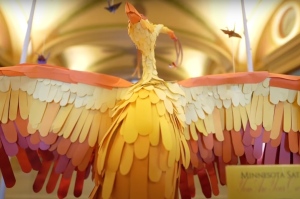Moon is Battered, Cracked Under Surface: See Amazing Photos
Earth's moon is battered and its crust is riddled with cracks that go may go for miles underneath its surface, according to a new gravity map by NASA. The high-resolution gravity data shows the density of the moon is lower than scientists generally assumed.
"We have known that the moon's crust and other planetary crusts have been bombarded by impacts, but none of us could have predicted just how cracked the lunar crust is," said Maria Zuber, the MIT geoscientist who led the GRAIL (Gravity Recovery and Interior Laboratory) mission, the Boston Globe reported.
The GRAIL map is the highest resolution gravity field map of any body in space. It was created by data collected from two spacecrafts orbiting the moon, measuring the distance of the surface in relation to itself. The names of the two washing-machine size crafts were Ebb and Flow.
After analyzing the results showing the highland crust is "substantially" lower than predicted, scientists concluded that the moon is battered.
"This data revealed a population of long, linear gravity anomalies, with lengths of hundreds of kilometers, crisscrossing the surface. These linear gravity anomalies indicate the presence of dikes, or long, thin, vertical bodies of solidified magma in the subsurface. The dikes are among the oldest features on the moon, and understanding them will tell us about its early history," said Jeff Andrews-Hanna, a GRAIL scientist at the Colorado School of Mines.
The cracks in the battered moon also provided researchers insight on how other planets like Mars may have sustained life.
"There isn't a lot of water in the moon, but think about Mars," said Zuber. "The Martian crust must be similarly fractured up, and Mars used to have an ocean on its surface. ... If there ever was life on Mars, and the climate on Mars changed drastically and early microbes need to find a place to live, they could've made their way into the deep surface and gone deep into the crust, where it would have been warmer and more hospitable."
Research showing the moon is battered also yielded evidence to support the theory how the moon came to be in existence. Ebb and Flow, the name of the two spacecrafts, also collected information that allowed scientists to support the "giant impact theory," which says that the moon was the by-product of large projectiles slamming into Earth. Scientists were able to estimate that the amount of aluminum in the moon's crust were similar to that of Earth's.
"With this crustal thickness, the bulk composition of the moon is similar to that of Earth. This supports models where the moon is derived from Earth materials that were ejected during a giant impact event early in solar system history," said Mark Wieczorek, co-investigator of the GRAIL mission.
The results of the GRAIL mission were published online by the journal Science Express.





























